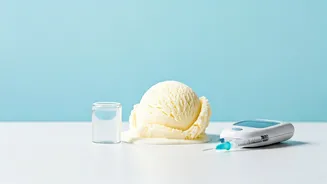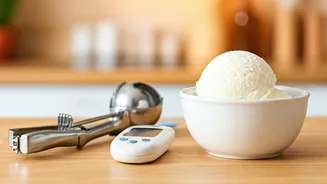Ice Cream: A Dilemma?
Ice cream, a beloved dessert across India, often presents a challenge for individuals with diabetes. The high sugar content in many commercially available
varieties can cause blood sugar levels to spike rapidly. However, completely denying oneself this treat isn't always necessary or desirable. Understanding the factors involved, like the type of ice cream, portion sizes, and frequency of consumption, can empower people with diabetes to make informed choices. The key lies in balancing enjoyment with health management. Careful selection and mindful consumption are essential to integrating ice cream into a diabetes-friendly diet. Considering the broader dietary context, including meals and physical activity levels, is also crucial for maintaining stable blood glucose levels and overall well-being. This perspective encourages a balanced approach, allowing individuals to enjoy life's pleasures responsibly without compromising their health.
Blood Sugar's Role
Understanding how ice cream influences blood sugar is fundamental for people with diabetes. When ice cream, which is typically rich in carbohydrates and sugars, is consumed, these sugars are broken down into glucose and absorbed into the bloodstream. This process leads to an increase in blood sugar levels, or a 'blood sugar spike.' The magnitude of this spike depends on several variables, including the quantity of ice cream eaten, the specific ingredients used, and the individual's insulin sensitivity. For individuals with diabetes, the body either doesn't produce enough insulin or can't effectively use the insulin it produces, which is essential to manage blood sugar. Therefore, the consumption of ice cream necessitates careful attention to carbohydrate intake and blood sugar monitoring. This allows people to make necessary adjustments to medication, diet, or exercise to minimize any negative impacts. By learning to recognize the impact of different ice cream varieties on blood sugar, individuals can make informed choices and develop a dietary plan that integrates ice cream in moderation while prioritizing stable blood sugar levels.
Diabetes-Friendly Choices
Selecting the right ice cream options can make a significant difference for individuals with diabetes. Opting for ice creams that have lower sugar content is an effective starting point. Many brands now offer sugar-free or reduced-sugar varieties that use artificial sweeteners, sugar alcohols, or natural alternatives like stevia. These options often result in a smaller impact on blood sugar levels compared to traditional ice cream. Paying close attention to the ingredient list is critical. Look for ice creams that have a lower carbohydrate content per serving, as carbohydrates are the primary drivers of blood sugar spikes. Prioritizing ice creams made with natural ingredients and avoiding those with added artificial flavors, colors, and preservatives can also be beneficial. Another practical approach is to consider portion control. Regardless of the ice cream's sugar content, enjoying smaller servings can help manage blood sugar responses more effectively. By focusing on these principles, people with diabetes can make informed decisions when selecting ice cream, allowing them to indulge in a treat without causing excessive fluctuations in blood sugar. Remember that the best approach often involves experimenting with different options and monitoring blood sugar levels to see how each type affects the individual.
Smart Consumption Tips
To enjoy ice cream safely with diabetes, several smart consumption tips should be followed. Careful portion control is essential. Rather than having a large serving, it is often best to opt for a smaller amount to minimize the carbohydrate intake. Monitoring blood sugar before and after eating ice cream is highly recommended. This allows individuals to gauge the impact of their choice and make appropriate adjustments to their diet or medication if needed. It is also advisable to eat ice cream as part of a balanced meal. Pairing it with protein, healthy fats, and fiber can help slow down the absorption of sugar and prevent rapid spikes in blood sugar levels. For example, consider including ice cream as part of a meal that includes nuts or seeds. Furthermore, timing is also important. Consuming ice cream at times when blood sugar levels are generally more stable, such as after a meal, may be preferable. Physical activity also plays a crucial role. Engaging in regular exercise can help improve insulin sensitivity and improve glucose management. Incorporating this into the diet can help stabilize blood sugar levels.
Considering the Factors
Several other factors can influence how ice cream affects blood sugar. Individual metabolic differences play a role, as the body's response to sugar can vary. Factors like age, weight, and activity level can impact insulin sensitivity and glucose tolerance. The timing of when ice cream is consumed in relation to meals and medication also matters. For instance, taking insulin injections before meals can help counter the blood sugar spike caused by ice cream. The ingredients of ice cream itself are an important consideration. Ice creams with high-fat content can slow down the absorption of sugars, potentially causing a slower and steadier rise in blood sugar compared to low-fat options. However, it's also important to consider the overall nutritional profile, as high-fat ice creams can also be high in calories. Environmental factors, like stress and sleep, can also affect blood sugar levels, which can influence how the body reacts to ice cream. Understanding these factors and consulting with healthcare professionals can help individuals with diabetes make personalized choices and manage their blood sugar effectively while incorporating ice cream in their diet.











